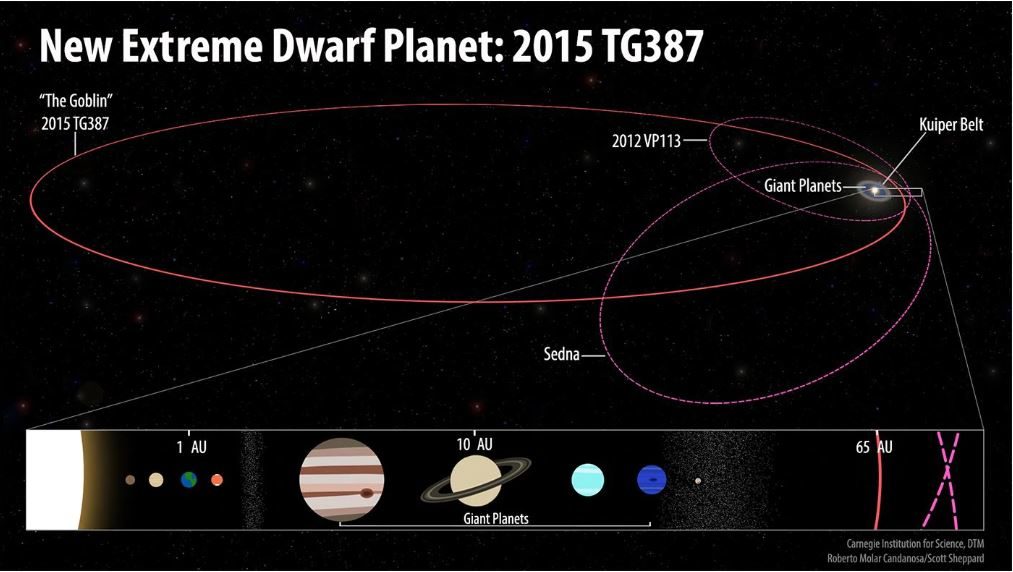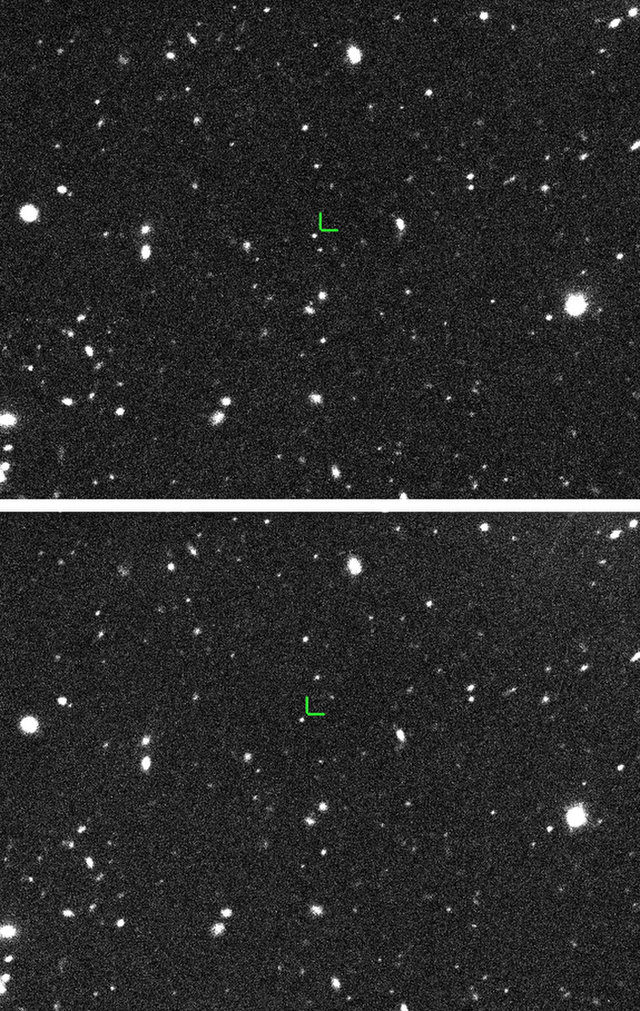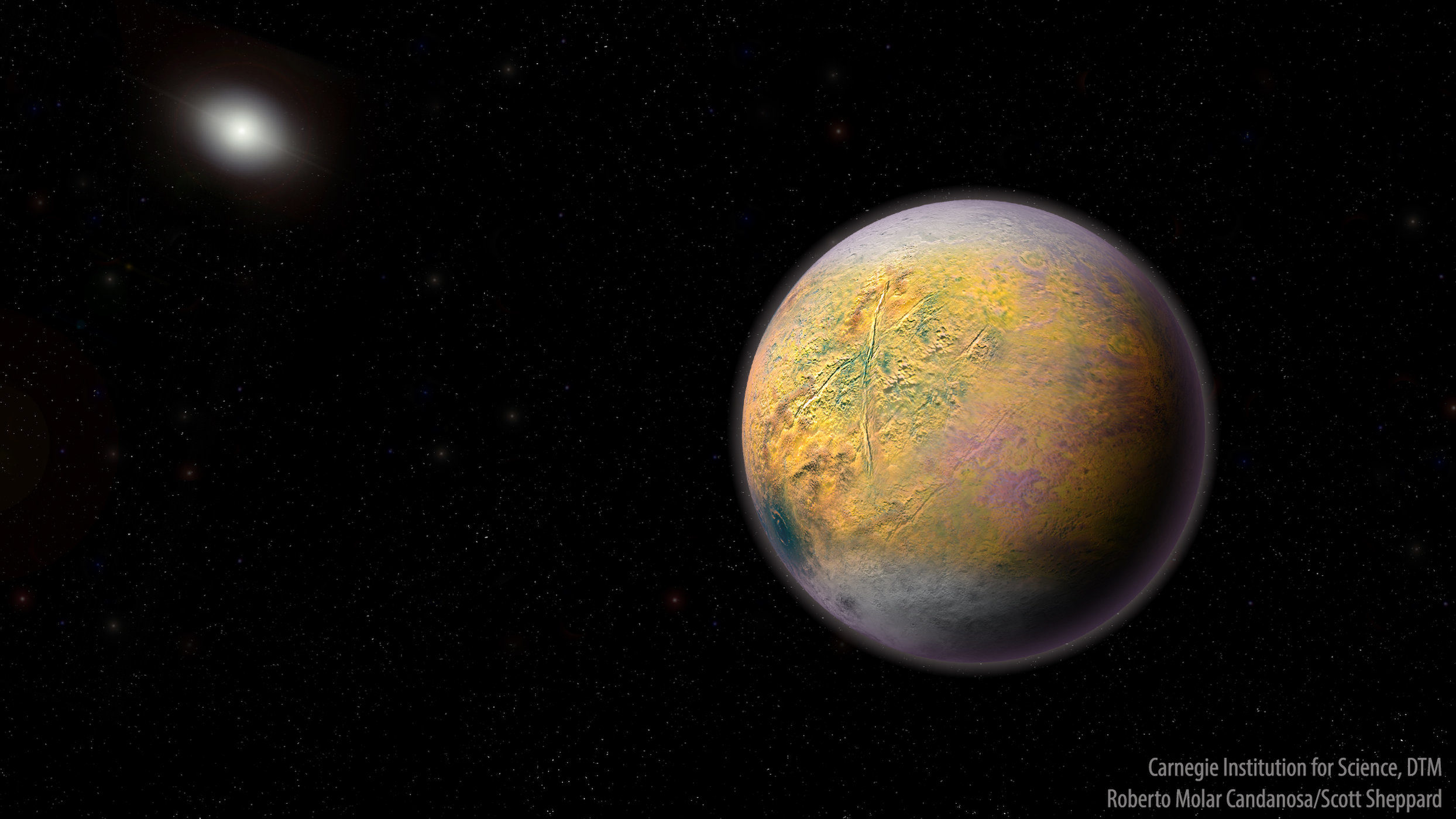
That clue is 2015 TG387, a newfound object in the far outer solar system, way beyond Pluto. The orbit of 2015 TG387 shares peculiarities with those of other extremely far-flung bodies, which appear to have been shaped by the gravity of a very large object in that distant, frigid realm - the hypothesized Planet Nine, also known as Planet X.
"These distant objects are like breadcrumbs leading us to Planet X," study leader Scott Sheppard, of the Carnegie Institution for Science in Washington, D.C., said in a statement.
"The more of them we can find, the better we can understand the outer solar system and the possible planet that we think is shaping their orbits - a discovery that would redefine our knowledge of the solar system's evolution," he added.
And 2015 TG387 is special among these bread crumbs, because it was found during a relatively uniform survey of the northern and southern skies rather than a targeted hunt for clustered objects in certain parts of the sky, Sheppard said. Targeted hunts can produce biased results - for example, the appearance of clustering where none may actually exist, he explained.

"And then if you bring in some of the other extreme objects - several of them were found in our survey as well," Sheppard told Space.com. "The statistics get better and better that this planet is likely out there."
Sheppard and his colleagues first spotted 2015 TG387 in October 2015, using Japan's 26-foot (8 meters) Subaru telescope atop the volcanic peak Mauna Kea in Hawaii. The researchers nicknamed the object "The Goblin," because of the discovery date and the "TG" in the provisional designation.
It took the team three additional years to nail down The Goblin's orbit, which they did with the aid of observations by the Las Campanas Observatory in Chile and the Discovery Channel Telescope in Arizona.
2015 TG387 loops around the sun on an extremely elliptical path, coming within about 65 astronomical units (AU) of the sun at its closest point (known as perihelion) and getting about 2,300 AU away at its most distant (aphelion).
One AU is the average Earth-sun distance - about 93 million miles (150 million kilometers). So 2015 TG387 is way, way out there. Indeed, it takes about 40,000 Earth years for the newfound object to complete one lap around the sun.

Sheppard and his colleagues think 2015 TG387 is about 186 miles (300 km) wide and probably spherical, in which case it would qualify as a dwarf planet. But that's all they can really say about The Goblin's physical characteristics.
"It's pretty faint, so we can really just see that it's there," Sheppard told Space.com. "We don't even know the color of the object; we haven't gotten any spectroscopy on the object yet, or anything like that."
(The 186-mile diameter is not a measurement but rather an estimate, assuming a "moderate" reflectiveness for 2015 TG387.)
But going back to the orbit: The Goblin's is similar in key ways to those of some other extremely distant bodies - particularly in an element called "longitude of perihelion." Basically, the elongated parts of their elliptical orbits are clustered in the same part of the sky, which is consistent with gravitational shepherding by Planet X.
The existence of Planet X was first seriously proposed in 2014 by Sheppard and Trujillo, to potentially explain oddities in the orbits of 2012 VP113, Sedna and a few other trans-Neptunian objects.
Comment: Eh, no. It was first seriously proposed decades ago by James McCanney, but because he was 'excommunicated' by 'the Scientific Community' for having ideas that don't conform with a 'stable universe', it was laughed off.
Planet-X, Comets and Earth Changes by J.M. McCanney
In 2016, astronomers Konstantin Batygin and Mike Brown presented more evidence for such an unseen "perturber," which they called Planet Nine. Batygin and Brown have suggested that this world may be about 10 times more massive than Earth and orbit about 600 AU from the sun on average.
In the new study, the researchers also performed computer simulations to test how Planet X's gravitational tug might influence the orbit of The Goblin. They found significant shepherding akin to that inferred for other distant objects - and determined that 2015 TG387's orbit remains stable for the age of the solar system nonetheless.
"What makes this result really interesting is that Planet X seems to affect 2015 TG387 the same way as all the other extremely distant solar system objects," Trujillo, who's based at Northern Arizona University, said in the same statement. "These simulations do not prove that there's another massive planet in our solar system, but they are further evidence that something big could be out there."
Comment: And that 'thing' is probably 'Nemesis', a twin Sun.
Sheppard puts the odds of Planet X's existence at around 85 percent. And he says it's not at all surprising that astronomers haven't spotted it yet.
"Where we think the planet is - hundreds of AU away, if not 1,000 AU - something even as big as Neptune would be fainter than most telescopes could see," Sheppard told Space.com. (In case this sounds odd or incongruous: The Goblin was discovered near perihelion, at about 80 AU from the sun.)
"And most of our surveys to date do not go that faint, do not go that deep. We've covered very little of the sky to the depth that's needed to be covered to find something this faint," he added. "You can hide a very big thing in the outer solar system very easily."
The paper describing the discovery of 2015 TG387 has been submitted to The Astronomical Journal.
Follow Mike Wall on Twitter @michaeldwall and Google+. Follow us @Spacedotcom, Facebook or Google+. Originally published on Space.com.



Comment: For more on 'Planet' X, or Nemesis, see:
- Sott Exclusive: Nemesis, not 'Nibiru' - Clarifying mainstream reports about 'a large ninth planet' that periodically sends comets our way
- Planet-X, Comets and Earth Changes by J.M. McCanney
- A Different Kind of Catastrophe - Something Wicked This Way Comes
- Nemesis - The Sun's long-lost twin
- Powerful magnetic field and auroras detected on Brown Dwarf 'star' 20 light years from Earth - Discovery defies (known) astrophysics
- Planet X or Cosmic Thunderbolts ? Mass extinctions in the Electric Universe
- Astronomers say a Neptune-sized ninth planet may lurk beyond Pluto
- Study: Our sun probably has an evil twin called Nemesis
Also check out SOTT radio's: